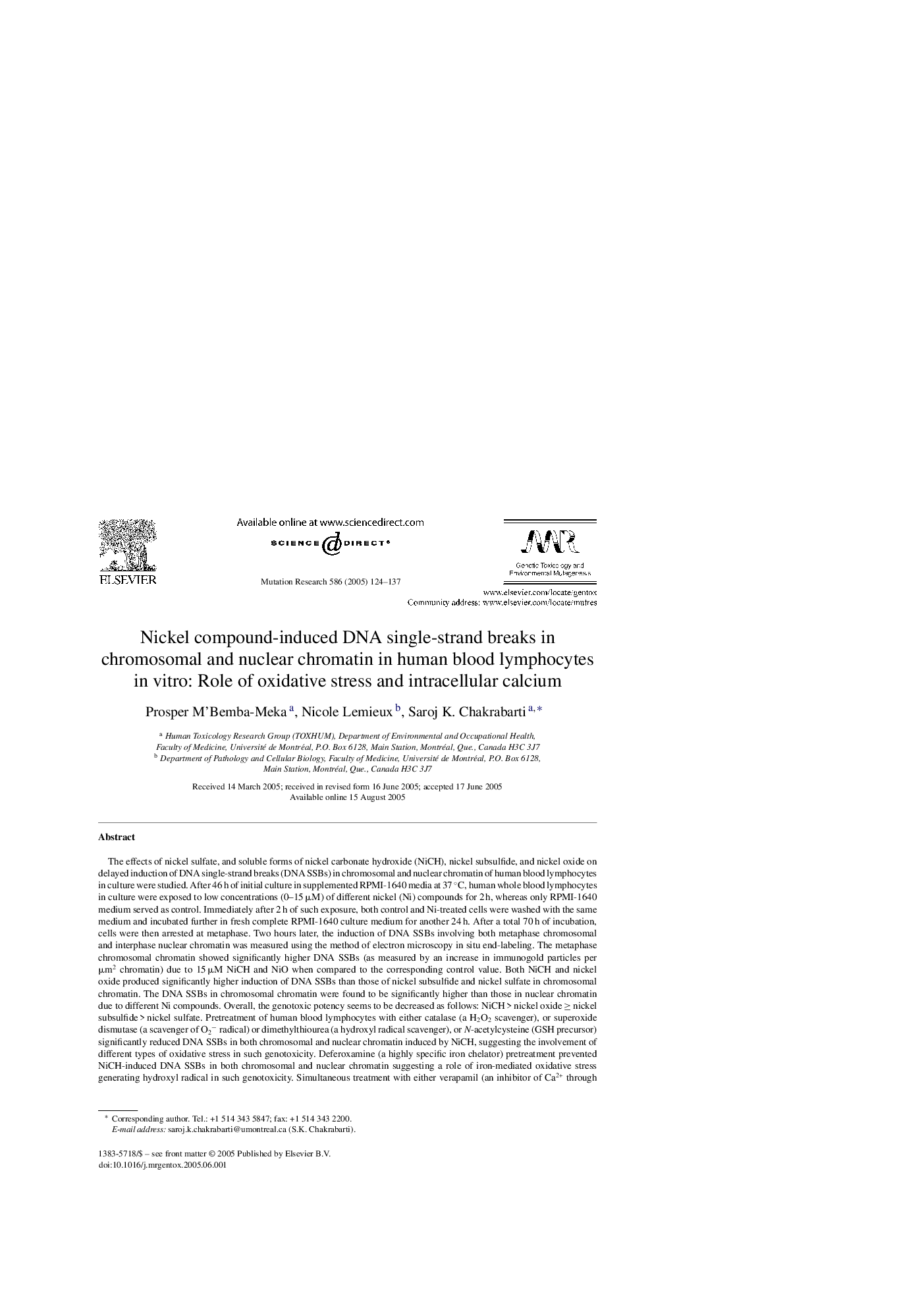| کد مقاله | کد نشریه | سال انتشار | مقاله انگلیسی | نسخه تمام متن |
|---|---|---|---|---|
| 10915061 | 1089630 | 2005 | 14 صفحه PDF | دانلود رایگان |
عنوان انگلیسی مقاله ISI
Nickel compound-induced DNA single-strand breaks in chromosomal and nuclear chromatin in human blood lymphocytes in vitro: Role of oxidative stress and intracellular calcium
دانلود مقاله + سفارش ترجمه
دانلود مقاله ISI انگلیسی
رایگان برای ایرانیان
کلمات کلیدی
موضوعات مرتبط
علوم زیستی و بیوفناوری
بیوشیمی، ژنتیک و زیست شناسی مولکولی
تحقیقات سرطان
پیش نمایش صفحه اول مقاله

چکیده انگلیسی
The effects of nickel sulfate, and soluble forms of nickel carbonate hydroxide (NiCH), nickel subsulfide, and nickel oxide on delayed induction of DNA single-strand breaks (DNA SSBs) in chromosomal and nuclear chromatin of human blood lymphocytes in culture were studied. After 46 h of initial culture in supplemented RPMI-1640 media at 37 °C, human whole blood lymphocytes in culture were exposed to low concentrations (0-15 μM) of different nickel (Ni) compounds for 2 h, whereas only RPMI-1640 medium served as control. Immediately after 2 h of such exposure, both control and Ni-treated cells were washed with the same medium and incubated further in fresh complete RPMI-1640 culture medium for another 24 h. After a total 70 h of incubation, cells were then arrested at metaphase. Two hours later, the induction of DNA SSBs involving both metaphase chromosomal and interphase nuclear chromatin was measured using the method of electron microscopy in situ end-labeling. The metaphase chromosomal chromatin showed significantly higher DNA SSBs (as measured by an increase in immunogold particles per μm2 chromatin) due to 15 μM NiCH and NiO when compared to the corresponding control value. Both NiCH and nickel oxide produced significantly higher induction of DNA SSBs than those of nickel subsulfide and nickel sulfate in chromosomal chromatin. The DNA SSBs in chromosomal chromatin were found to be significantly higher than those in nuclear chromatin due to different Ni compounds. Overall, the genotoxic potency seems to be decreased as follows: NiCH > nickel oxide â¥Â nickel subsulfide > nickel sulfate. Pretreatment of human blood lymphocytes with either catalase (a H2O2 scavenger), or superoxide dismutase (a scavenger of O2â radical) or dimethylthiourea (a hydroxyl radical scavenger), or N-acetylcysteine (GSH precursor) significantly reduced DNA SSBs in both chromosomal and nuclear chromatin induced by NiCH, suggesting the involvement of different types of oxidative stress in such genotoxicity. Deferoxamine (a highly specific iron chelator) pretreatment prevented NiCH-induced DNA SSBs in both chromosomal and nuclear chromatin suggesting a role of iron-mediated oxidative stress generating hydroxyl radical in such genotoxicity. Simultaneous treatment with either verapamil (an inhibitor of Ca2+ through plasma membranes), or dantrolene (an inhibitor of mobilization of [Ca2+]i from endoplasmic reticulum), or BAPTA (a Ca2+ chelator) significantly reduced Ni compound-induced DNA SSBs in both chromosomal and nuclear chromatin, suggesting that Ni compound-induced destabilization of calcium homeostasis may also involved in the induction of such DNA SSBs.
ناشر
Database: Elsevier - ScienceDirect (ساینس دایرکت)
Journal: Mutation Research/Genetic Toxicology and Environmental Mutagenesis - Volume 586, Issue 2, 3 October 2005, Pages 124-137
Journal: Mutation Research/Genetic Toxicology and Environmental Mutagenesis - Volume 586, Issue 2, 3 October 2005, Pages 124-137
نویسندگان
Prosper M'Bemba-Meka, Nicole Lemieux, Saroj K. Chakrabarti,